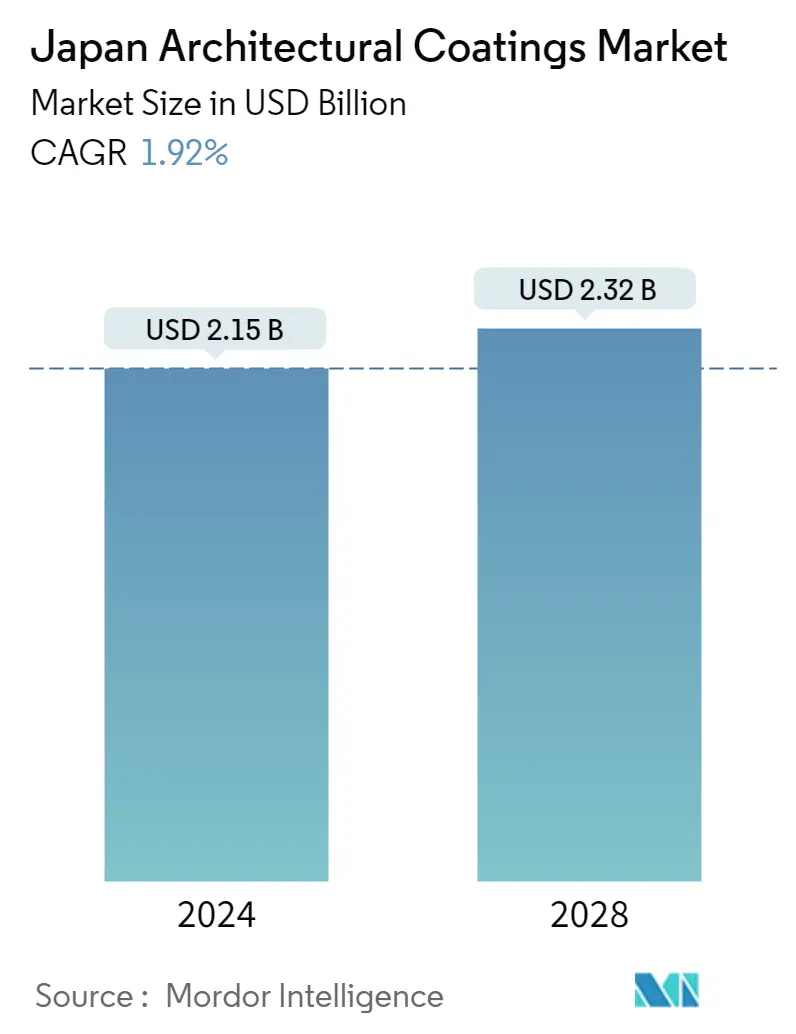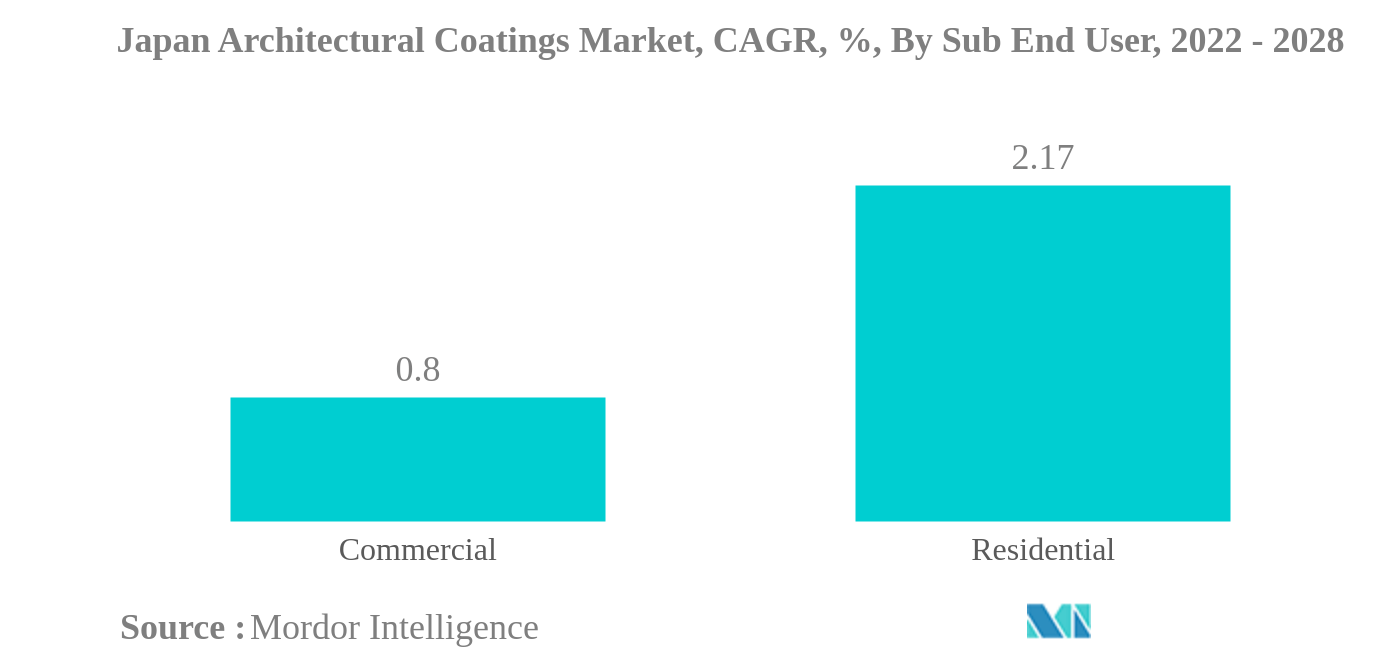Market Size of japan architectural coatings Industry

| Icons | Lable | Value |
|---|---|---|
|
|
Study Period | 2016 - 2028 |
|
|
Market Size (2024) | USD 2.15 Billion |
|
|
Market Size (2028) | USD 2.32 Billion |
|
|
Largest Share by Sub End User | Residential |
|
|
CAGR (2024 - 2028) | 1.92 % |
|
|
Fastest Growing by Sub End User | Residential |
|
|
Market Concentration | High |
Major Players |
||
|
|
||
|
*Disclaimer: Major Players sorted in no particular order |
Japan Architectural Coatings Market Analysis
The Japan Architectural Coatings Market size is estimated at USD 2.15 billion in 2024, and is expected to reach USD 2.32 billion by 2028, growing at a CAGR of 1.92% during the forecast period (2024-2028).
- Largest Segment by End-user - Residential : Compared to commercial floor area, Japan has been observing higher volume of residential building floor area resulting in high architectural paint consumption from the residential sector.
- Largest Segment by Technology - Waterborne : Japan has Voluntary VOC requirements, hence compared to the other regions consumption of Solventborne technology is higher, though Waterborne technology is largest segment by technology.
- Largest Segment by Resin - Acrylic : Acrylic is a leading type of resin in Japan. Further, Epoxy resins and Polyurethane resins in Japan has higher percentage of consumption in comparison to other regions.
This section covers the major market trends shaping the Japan Architectural Coatings Market according to our research experts:
Residential is the largest segment by Sub End User.
- The growth rate of architectural coatings in Japan has been on decline since 2016 before observing a spike back in 2020. The growth registered in 2020 is due to sales increase from the DIY segment, influenced by COVID enhanced home improvement activity. The Japanese home structures also warrants a higher paint consumption as in comparison to other housing structure around world, Japan has different specifications as their style of houses are drastically different.
- Japan’s residential sector held the highest share, which oscillates around 80%. This has enabled the total architectural paint and coatings consumption to witness a CAGR of 2.48% in the period 2016-2021, even though the commercial sector has observed a few negative growth rate years in the said period.
- The commercial sector's share in Japan is expected to reduce during the forecast period, due to sustained demand in the residential segment, coupled with declining population and aging labor force. Additionally, Japan is a highly developed country coupled with country observing deflation for a prolonged period of time, this has affected the overall growth of the country, similarly, the overall architectural paints and coatings market is expected to continue but at a mere CAGR of 1.3% between the period 2022-2028.

Japan Architectural Coatings Industry Segmentation
Commercial, Residential are covered as segments by Sub End User. Solventborne, Waterborne are covered as segments by Technology. Acrylic, Alkyd, Epoxy, Polyester, Polyurethane are covered as segments by Resin.
| Sub End User | |
| Commercial | |
| Residential |
| Technology | |
| Solventborne | |
| Waterborne |
| Resin | |
| Acrylic | |
| Alkyd | |
| Epoxy | |
| Polyester | |
| Polyurethane | |
| Other Resin Types |
Japan Architectural Coatings Market Size Summary
The Japan Architectural Coatings Market is characterized by a significant focus on the residential sector, which dominates the market due to the higher volume of residential building floor area compared to commercial spaces. This trend has led to increased consumption of architectural paints, particularly in the residential segment, which holds a substantial share of the market. The market is also influenced by technological advancements, with waterborne technology being the largest segment due to Japan's voluntary VOC requirements. Acrylic resins are the leading type of resin used, with epoxy and polyurethane resins also seeing considerable consumption. The market has experienced fluctuations in growth, with a notable spike in 2020 attributed to increased DIY activities during the COVID-19 pandemic, which boosted home improvement efforts.
Despite the challenges posed by a declining population and an aging labor force, the residential sector's sustained demand is expected to continue driving the market, while the commercial sector's share is anticipated to decrease. The market's growth has been moderate, with a projected CAGR over the forecast period. The industry is moderately consolidated, with major players like AkzoNobel N.V., DAI NIPPON TORYO CO.,LTD., Kansai Paint Co.,Ltd., Nippon Paint Holdings Co., Ltd., and SKK(S) Pte. Ltd. holding significant market shares. Recent product launches, such as Kansai Paint's "Dyna Axel" and Nippon Paint's anti-viral water-based paints, highlight ongoing innovation and adaptation to market demands.
Japan Architectural Coatings Market Size - Table of Contents
-
1. MARKET SEGMENTATION
-
1.1 Sub End User
-
1.1.1 Commercial
-
1.1.2 Residential
-
-
1.2 Technology
-
1.2.1 Solventborne
-
1.2.2 Waterborne
-
-
1.3 Resin
-
1.3.1 Acrylic
-
1.3.2 Alkyd
-
1.3.3 Epoxy
-
1.3.4 Polyester
-
1.3.5 Polyurethane
-
1.3.6 Other Resin Types
-
-
Japan Architectural Coatings Market Size FAQs
How big is the Japan Architectural Coatings Market?
The Japan Architectural Coatings Market size is expected to reach USD 2.15 billion in 2024 and grow at a CAGR of 1.92% to reach USD 2.32 billion by 2028.
What is the current Japan Architectural Coatings Market size?
In 2024, the Japan Architectural Coatings Market size is expected to reach USD 2.15 billion.

